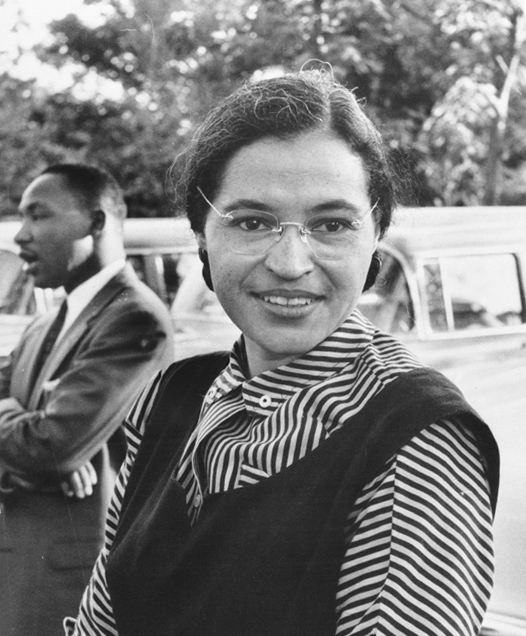Rosa Parks Was Not Tired That Day
Rosa Louise McCauley Parks was born on Feb 4, 1913 in Tuskegee, Alabama and died on Oct 24, 2005 in Detroit, Michigan. Her mother was a teacher and her father a carpenter. Rosa lived to the ripe old age of 92 and did not have any children of her own. During those 92 years she never waivered from her absolute commitment to civil rights activism. She worked tirelessly to further many causes ranging from pushing for voter registration, to supporting wrongfully accused black Americans, to addressing inequalities in schools and housing. No, Rosa Parks was not tired that day on Dec 1, 1955 when she refused to give up her seat on the bus. She was committed to making change.

https://en.wikipedia.org/wiki/Rosa_Parks
Rosa Parks Legacy
A quick synopsis of the Rosa Parks legacy reveals that she was a feisty young girl who watched with increasing resolve how the division between the African Americans and white people manifested itself. She had to walk to the segregated and underfunded school with her classmates, while they watched the school bus take their white counterparts to their new school building. Her school lacked basic supplies – like desks.

Rosa did not finish highschool immediately, as she had to tend to her ill mother and grandmother. She began working in Montgomery, Alabama where she met and married Raymond Parks at age 19. Raymond was an active member of the National Association for the Advancement of Coloured People (NAACP). A fortuitous union for Rosa, as it allowed her to channel her ambitions to make a difference and stand up for civil rights. Rosa became secretary of the Montgomery chapter of the NAACP and held that post for nearly 15 years.
One fateful evening after work, on Dec 1, 1955, as Rosa boarded the bus home, she took her stand. The Montgomery City Code required all public transportation to be segregated and that buses provide equal, but separate, seats for blacks and whites. The front half of the bus was designated for white folks and the rear for blacks. The Montgomery bus drivers were more or less given police-like authority to carry out this law as they saw fit. There was a sign marking the invisible barrier between the white and black ends of the bus. If the bus got busy and the bus driver wanted to give more room to the whites, he would simply move the sign and ask the black occupants to move out of their seats. If someone violated the law, or disobeyed requests, the bus driver would call the police and the person would be arrested.

That evening, the bus driver wanted to move the sign back one row and asked the occupants of the first row of black seats to stand up. Rosa Parks was in that row.
Much has been written about the chronology of events after that moment and ensuing arrest and trial. All of this can be easily found online. There are, however, some thought provoking details that deserve to be highlighted, to give further depth to the legacy of Rosa Parks.
There was no rule to give up seats
The Montgomery City Code did not include a provision or give authority to bus drivers to request anyone to give up their seats, white or black. This just became a custom of the Montgomery bus drivers to ask black passengers to move when the bus was full and white people had to stand in the aisles.
Rosa was sitting in the designated seats for blacks
Rosa was sitting in the correct row of seats. She was not occupying any white person’s seat. It only became a white person’s seat when the bus driver wanted to move the sign to include it. Technically speaking the bus was supposed to be divided into equal numbers of seats – 10 front rows for whites, and 10 rear rows for blacks. By moving the sign one row back, it effectively gave the whites 11 rows and the blacks 9 rows. Not sure what math they were using, but this equation is no longer equal.

When the bus driver asked Rosa, “Are you going to stand up?”, she said “No, I’m not”. When he repeated his request and asked “Why don’t you stand up?”, Rosa replied, “I don’t think I should have to.” In that moment she drew strength from Martin Luther King Jr. who said that “some of us must bear the burden of trying to save the soul of America”. Rosa later recounted that “When I made that decision, I knew I had the strength of my ancestors with me”. “The time had just come when I had been pushed as far as I could stand to be pushed, I suppose. I decided that I would have to know, once and for all, what rights I had as a human being, and a citizen.”
This was not the first bus sit-in
Rosa’s moment of resolve to refuse to stand up and move on the bus was not the first example of blacks refusing to give up their seats. There were 5 other occasions by individuals in Montgomery dating from 1942 to protest in this way. These previous attempts, for whatever reason, did not garner the same impact as Rosa’s. When the bus driver told her that if she was not going to stand up, then he would have to call the police, she replied simply, “You may do that.”
Montgomery Bus Boycott
The reaction to Rosa’s arrest was swift and decisive in the black community of Montgomery. Her arrest on Dec 1, 1955 was on a Thursday. By Sunday, a full scale boycott of the buses was announced and communicated through handbills, newspaper ads and rallies. Blacks were encouraged to boycott the buses on Monday Dec 5, the day of Rosa’s trial. When you realize that more than three quarters of the patrons of the Montgomery buses were black, this move had the potential for serious consequences to the bus company.

The defiance of the black community gained momentum and the boycott lasted not just for one day as planned, but an incredible 381 days. The black community agreed unanimously that they sought to be treated with respect and courtesy, they wanted black drivers to be hired, and that the seating in the middle row of the bus would be first come, first served. In court, Rosa’s case went even further and challenged the legality of segregation on public transportation.
They held fast to the boycott for over a year, children and adults included. Consider for a moment the hardship and inconvenience this action caused, willingly, for the 40,000 black commuters just trying to get to school, to work, to socialize or to shop. Some carpooled, some used black owned taxis, most simply walked. Some walked 20 miles a day (30km).
It became clear to the Montgomery Bus Lines, that with the number of city buses sitting idle over the ensuing months, something had to be done or they would suffer financial ruin. The law was repealed. The Montgomery Bus Boycott was the first large scale demonstration against segregation in US history.
Bus Driver James F. Blake
It’s important to keep the name of the bus driver who called the police to arrest Rosa as much at the forefront of the Rosa Parks story as Rosa herself. Specifically because in the years following her arrest and trial, Rosa and Raymond Parks both lost their jobs and had difficulty finding employment, received constant death threats and harassment and ultimately ended up leaving Montgomery and moving to Detroit to be closer to her brother. Life was not significantly better in Detroit, but both Rosa and Raymond continued their activism. Both were suffering from health issues by the late 1960’s and early 1970’s and whatever meager income they had was used to pay medical bills and contribute to the various causes Rosa was supporting.
James Blake, on the other hand, continued to be employed by the Montgomery Bus Lines until his retirement in 1974. He went right back to driving his routes following the trial of Rosa Parks. He even drove that very same bus #2857 on the Cleveland Ave route from time to time in the ensuing years. He maintained throughout his life that he was just a city employee doing his job. No doubt he also still maintained the custom of occasionally, as he saw fit, to drive away when a black passenger paid their fare at the front of the bus, but were required to exit and then re-enter the bus using the rear doors. He subjected Rosa to this humiliation on one more than one occasion.
Rosa Parks was not tired that day
No, Rosa Parks was not tired that day on Dec 1, 1955. Rosa wrote in her autobiography that “People always say that I didn’t give up my seat because I was tired, but that isn’t true. I was not tired physically or no more tired than I usually was at the end of a working day. I was not old, although some people have an image of me as being old then. I was forty-two. No, the only tired I was, was tired of giving in.”
We are thankful that Rosa did not give in on that day in history. Though it feels like she did not fully benefit from the gains that hers and other freedom fighters who succeeded her were able to achieve. It takes decades to make significant change. However, without the catalyst that Rosa represented, we may never even be where we are today. Yes, there are still significant milestones to be scaled and much more work to be done.
Happy Birthday Rosa Parks Feb 4, 2021.



